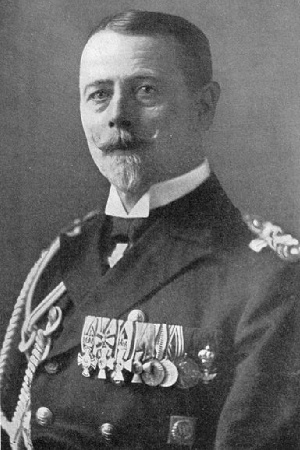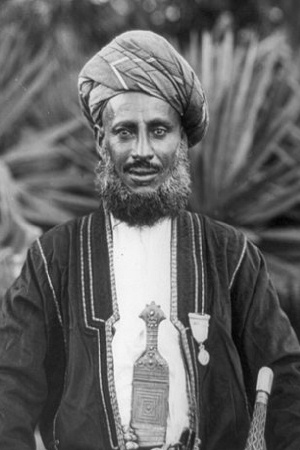|
Order of
the Red Eagle
As the Pour-le-Mérite was only
awarded on very rare occasions and the Iron Cross instituted
only during major wars, the Order of the Red Eagle ("Roter
Adlerorden") was
more commonly awarded to Prussian (and other German) officers
for colonial actions. It was awarded in several classes only the
third and fourth of which were awarded to officers in the field.
Crossed swords and a crown could be added to the award for
distinction. A lower Red Eagle Medal could be awarded to other
ranks.
When
several awards of the Red Eagle were made to the same recipient
in different classes, only the most senior was worn.
The exception was if the more junior was
distinguished by swords, a bow or a crown, in which case it could be
worn alongside a more senior award (see the photo of Admiral Friedrich von Ingenohl
to the right).
The example in the photograph
above is a 4th Class
award. One such as this was awarded to
Rittmeister Richard Haegele
for service while commanding the Field Bakery of the East Asian
Expeditionary Corps in China. He was later awarded the
decoration with swords for action in South West Africa.
Recommended External Link- The Medals of Richard Haegle at Medal Net
Crown Order
The Crown
Order ("Kronenorden") was the lowest Prussian Order of chivalry.
It was worn on a blue ribbon for awards during peacetime years
and on a ribbon like that of the Iron Cross
(black/white/black/white/black) for wartime awards. As with the Red Eagle, the third and fourth classes were awarded to
field officers and crossed swords could be added for
distinction. A Crown Medal was
awarded to other ranks.
The crown medal is is one of the few
German awards given to African soldiers in the colonies.
Examples have been seen worn by Togo Polizeitruppe NCO's (see Medals of a Togo Polizeitruppe NCO at the Gentlemen's Military Interest Club)
and loyal East African Arab Sultans (see the photo
of
Wali Mohamed bin Salim
to the right).
Warriors Merit
Medal
The Prussian Warriors Merit Medal ("Preussische
Kriegerverdienstmedaille") had previously been awarded to
soldiers of countries allied to Prussia, and was thus often
awarded to soldiers of other German states during the Wars of
Unification, Colonial Campaigns and First World War and to
servicemen of the Austro-Hungarian, Ottoman and Bulgarian armies
during the First World War.
In 1889,
Unteroffizier Chamba Wadi Hamit became the first African soldier
to be decorated in German service when he was awarded the
Prussian Military Honour Decoration ("Militärehrenzeichen"), second class for
bravery during the Abushiri Rebellion in German East Africa.
Soon after, the commander of the German forces in East Africa,
Hermann von Wissmann suggested the permanent
establishment of a bravery award for African soldiers in German
service. In
1892 a new
Imperial German (rather than only Prussian) Warriors Merit
Medal was instituted as an award for bravery for the askaris of East Africa.
On 25th March 1893 the award
was extended to non-European troops in the Schutztruppe and
Polizeitruppe of all colonies.
The new German Warriors Merit Medal
was identical in appearance to the previous Prussian award. It
consisted of a circular polished steel medal with a
stylised "WR" monogram surmounted by a Prussian crown on
the obverse and the motto "Krieger
Verdienst" within a laurel wreath on the reverse. Some surviving
medal bars show the Warriors Merit Medal worn reversed with the
"Krieger
Verdienst" showing rather than the monogram. Some Prussian
Warriors Merit Medals have been seen with the slightly different
motto "Kriegs Verdienst". The ribbon was vertically
striped black/white/black/white/black, similar to that worn with
the Iron Cross.
The first class award differed in
that the obverse bore a profile portrait of Kaiser Wilhelm II in Garde
du Corps uniform, surrounded by the title "Guilelmus II Imperator"
(see Medals.Org.Uk).
It was also noticeably larger with a diameter of 4cm rather than
2.5cm for the second class. In 1895 a "Gold" class of the medal was instituted. Aside
from being in bronze it was identical to the silver medal in both
the a larger first class and the smaller second class awards.
Between 1892 and 1914,
1,491 Warriors Merit Medals were awarded to non-European troops
in the Schutztruppe and Polizeitruppe. A further 2,425 of various
classes were sent aboard the "Marie" blockade running ship to German
East Africa in 1916 for awards to askaris during the First World
War.
Recommend External
Link -Gentlemen's Military Interest Club discussion on the Kriegerverdienstmedaille
Highly Recommended Reading- "Askari
und Fita-Fita" by Thomas Morlang
Long Service Awards
The four German kingdoms
(Prussia, Bavaria, Saxony and Württemberg) and some other states (such
as Hessen) each
issued their own long service awards ("Dienstauszeichnung") to their soldiers. Prussian
long service awards were awarded to troops from the remaining states
(such as Baden) as
well as Imperial troops (such as the
Schutztruppe, East Asian Occupation Brigade, Navy and Marine Infantry). It should be noted that
each year of wartime, overseas or colonial service counted as two years
towards long service awards.
The Prussian other
ranks long service award came in three classes, third class for 9 years service,
second class for 15
years service and first class for 21 years service.
Each higher class award replaced the previous one, so
servicemen did not usually wear more than one long service award at a time.
These long service
awards were originally worn as a ribbon and clasp ("Schnalle") only, usually worn below the medal bar. The clasp bore
the "FW III" monogram and was in different metals for the
different classes: iron for third, white metal for second and
yellow metal for first class. The ribbon was blue with coloured
edging down either side: black for third, white for second and
yellow for first class.
From 1913 the awards
were replaced by medals worn on the upper left breast or bar.
The third class was a white metal circular medal bearing the
Prussian crown and the motto "Treue Dienste bei der Fahne"
(roughly translated as "loyal service under the flag"). The second
class was a yellow metal medal bearing the same crown and motto.
The first class was a bronze or yellow metal cross with the Prussian crown
in the centre. The ribbon for all classes was plain blue.
The Prussian officers long service cross was awarded for 25 years
service. It consisted of a yellow metal cross with the
"FW III" monogram in the centre on a blue ribbon.
There were two types
of Prussian Landwehr long service awards. The first class was
for officers who had served 20 years. It consisted of an iron
metal cross with the "WR" monogram on a yellow metal centre
hung on a blue ribbon. The Landwehr second class award was officers and other
ranks for completing three months active service or taking part
in a campaign. It originally consisted of a blue ribbon and an
iron clasp with the "FW IV" monogram. In 1913 this was changed
to a white metal circular medal with the Prussian crown and the
motto "Treue Dienste Reserve Landwehr") hung on
a blue ribbon. Landwehr long
service awards could be worn alongside (but behind) previous regular officers
or other ranks long service awards.
All Prussian long
service awards had the number of years in Roman numerals on the
reverse of the medal, except the Landwehr second class award
which had the motto "Landwehr Dienstauszeichnung II. Klasse".
Recommended
External Links- Discussion on Prussian Long Service Awards at the Gentlemen's Military Interest Club
Wikipedia pages on Dienstauszeichnung and Saxon
Dienstauszeichnung
Wilhelm I Centenary Medal
The Prussian Centenary Medal ("Zentenarmedaille") was awarded to all serving officers and other ranks of the
Prussian army, the German navy and
the Schutztruppe as well as to veterans of the Wars of German Unification on
22nd March 1897 to celebrate what would have been Kaiser
Wilhelm I's 100th birthday. As
such it was commonly seen on the medal bars of long serving
officers and NCOs in the colonies in the early 20th Century.
Red
Cross Medal
The Prussian Red Cross Medal ("Rote
Kreuz Medaille") was of course awarded for service in the
Red Cross medical volunteer service ("Freiwillige Krankenpflege"). The
Second and Third Class awards could be
awarded with the following yellow metal clasps for overseas
service:
"Südafrika 1899/1900"
for the Anglo-Boer War- 30 third class awards
"Ostasien 1900/01" for the Boxer Rebellion- 2
second class and 75 third class awards
"Peking" for the defence of the Foreign
Legations during the Boxer Rebellion- 5 third class
awards
"Charbin
1904/05" for the Russo-Japanese War- 10 third
class awards
"Südwestafrika
1904/06" for the Herero Rebellion- 5 second class and
about 100 third class awards
Six medics were awarded two clasps,
only one ever earned three. A single unofficial third class
award for the Greco-Turkish War has also been reported reading "Türkei
1897".
Recommended External Links - Articles on
the Prussian Red Cross medal at the Rev. Richard Jordan's Red Cross Medals, Wikipedia and Gentlemen's Military Interest
Club |
|

Admiral Friedrich von Ingenohl
Von
Ingenohl commanded the German High Seas Fleet for the
opening campaign of the First World War. The medals on his bar are worn in correct order for the
Imperial Navy with all the Prussian medals before those
from another state. The medals are the House Order of
Hohenzollern, Order of the Red Eagle third class with
crown, Order of the Red Eagle fourth class with bow,
Officers Long Service Award, South West Africa Campaign Medal,
China Campaign Medal, Wilhelm I Centenary Medal and
lastly the Saxe-Weimar-Eisenach Order of the White
Falcon. Note that as Ingennohl's fourth class Red Eagle has
a bow, he may wear it alongside his third class.
Photo from WikiCommons

Wali Mohamed bin Salim
Wali Mohamed bin Salim, shown here in 1902, was the Sultan of Mikindani
in East Africa. Like many local leaders he maintained his status under German
rule by working for them as a colonial official. As seen here he was awarded the
Prussian Crown Medal for his services.
Photo by Vincenti at the
Library of Congress /
Wikimedia

South West African Schutztruppe
NCO
He wears the South West
African Schutztruppe grey home uniform with blue collar, cuffs and
piping down the front. Note the NCO lace on the collar. On his left breast he wears
parade aiguillette cords and three Prussian awards- the
Military Honour Award second class, the Wilhelm I Centenary
Medal and below them a pre-1913 Prussian 9 year Long Service
Award.
Photo © JW Collection

See-Soldat,
III. Seebataillon, Tsingtao
This marine wears the
black Jäger style shako with black parade plume,
dark blue peacetime uniform with white piping and
yellow Litzen and the dark grey/black greatcoat. On
his left breast he wears the Prussian Military
Honour Award First Class.
Photo ©
Peter Klein |